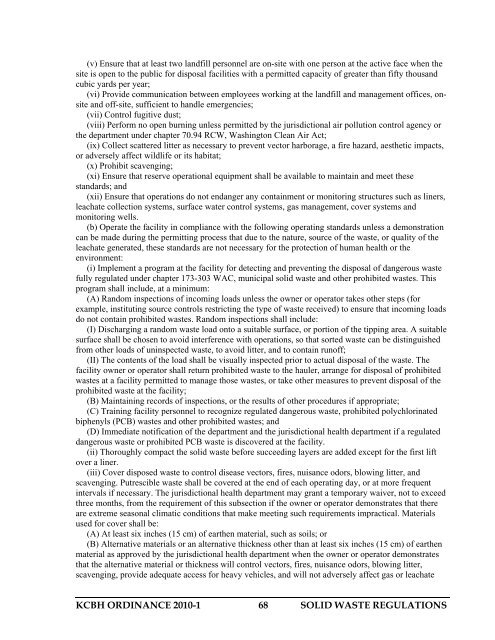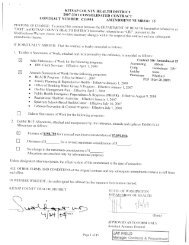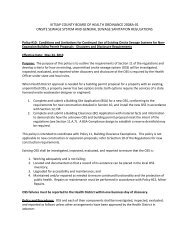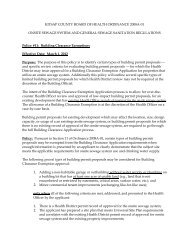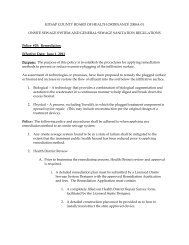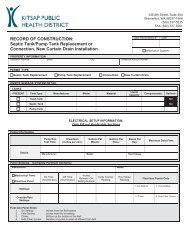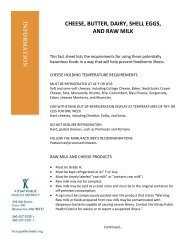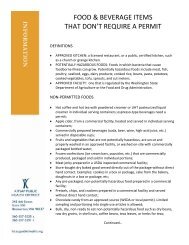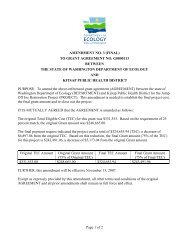SOLID WASTE REGULATIONS - Kitsap Public Health District
SOLID WASTE REGULATIONS - Kitsap Public Health District
SOLID WASTE REGULATIONS - Kitsap Public Health District
Create successful ePaper yourself
Turn your PDF publications into a flip-book with our unique Google optimized e-Paper software.
(v) Ensure that at least two landfill personnel are on-site with one person at the active face when the<br />
site is open to the public for disposal facilities with a permitted capacity of greater than fifty thousand<br />
cubic yards per year;<br />
(vi) Provide communication between employees working at the landfill and management offices, onsite<br />
and off-site, sufficient to handle emergencies;<br />
(vii) Control fugitive dust;<br />
(viii) Perform no open burning unless permitted by the jurisdictional air pollution control agency or<br />
the department under chapter 70.94 RCW, Washington Clean Air Act;<br />
(ix) Collect scattered litter as necessary to prevent vector harborage, a fire hazard, aesthetic impacts,<br />
or adversely affect wildlife or its habitat;<br />
(x) Prohibit scavenging;<br />
(xi) Ensure that reserve operational equipment shall be available to maintain and meet these<br />
standards; and<br />
(xii) Ensure that operations do not endanger any containment or monitoring structures such as liners,<br />
leachate collection systems, surface water control systems, gas management, cover systems and<br />
monitoring wells.<br />
(b) Operate the facility in compliance with the following operating standards unless a demonstration<br />
can be made during the permitting process that due to the nature, source of the waste, or quality of the<br />
leachate generated, these standards are not necessary for the protection of human health or the<br />
environment:<br />
(i) Implement a program at the facility for detecting and preventing the disposal of dangerous waste<br />
fully regulated under chapter 173-303 WAC, municipal solid waste and other prohibited wastes. This<br />
program shall include, at a minimum:<br />
(A) Random inspections of incoming loads unless the owner or operator takes other steps (for<br />
example, instituting source controls restricting the type of waste received) to ensure that incoming loads<br />
do not contain prohibited wastes. Random inspections shall include:<br />
(I) Discharging a random waste load onto a suitable surface, or portion of the tipping area. A suitable<br />
surface shall be chosen to avoid interference with operations, so that sorted waste can be distinguished<br />
from other loads of uninspected waste, to avoid litter, and to contain runoff;<br />
(II) The contents of the load shall be visually inspected prior to actual disposal of the waste. The<br />
facility owner or operator shall return prohibited waste to the hauler, arrange for disposal of prohibited<br />
wastes at a facility permitted to manage those wastes, or take other measures to prevent disposal of the<br />
prohibited waste at the facility;<br />
(B) Maintaining records of inspections, or the results of other procedures if appropriate;<br />
(C) Training facility personnel to recognize regulated dangerous waste, prohibited polychlorinated<br />
biphenyls (PCB) wastes and other prohibited wastes; and<br />
(D) Immediate notification of the department and the jurisdictional health department if a regulated<br />
dangerous waste or prohibited PCB waste is discovered at the facility.<br />
(ii) Thoroughly compact the solid waste before succeeding layers are added except for the first lift<br />
over a liner.<br />
(iii) Cover disposed waste to control disease vectors, fires, nuisance odors, blowing litter, and<br />
scavenging. Putrescible waste shall be covered at the end of each operating day, or at more frequent<br />
intervals if necessary. The jurisdictional health department may grant a temporary waiver, not to exceed<br />
three months, from the requirement of this subsection if the owner or operator demonstrates that there<br />
are extreme seasonal climatic conditions that make meeting such requirements impractical. Materials<br />
used for cover shall be:<br />
(A) At least six inches (15 cm) of earthen material, such as soils; or<br />
(B) Alternative materials or an alternative thickness other than at least six inches (15 cm) of earthen<br />
material as approved by the jurisdictional health department when the owner or operator demonstrates<br />
that the alternative material or thickness will control vectors, fires, nuisance odors, blowing litter,<br />
scavenging, provide adequate access for heavy vehicles, and will not adversely affect gas or leachate<br />
KCBH ORDINANCE 2010-1 68 <strong>SOLID</strong> <strong>WASTE</strong> <strong>REGULATIONS</strong>


